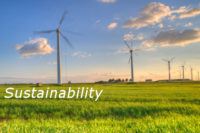As Tyson Foods prepares to release its fifth sustainability report, I have been thinking about the connection between sustainability reporting and social media.
Social media has revolutionized the way companies share information. Corporate functions such as marketing and public relations “get it” and have embraced this dynamic communication channel.
I believe social media applications can be a powerful communication resource for sustainability. Applications such as Facebook and YouTube provide an efficient means for not only sharing sustainability-related information but also engaging stakeholders in sustainability discussions.
Yet when it comes to communicating sustainability performance, most companies still produce traditional, data-heavy sustainability reports that likely go unread and are mostly one-way conversations with stakeholders. Most companies do not engage and make their reporting efforts available through social-media channels and thus are missing a significant opportunity to ensure their sustainability message is received.
A common thread
The fundamental links between sustainability reporting and social media are transparency and stakeholder engagement.
Stakeholders, especially customers, consumers and local communities, are demanding more and more transparent information about how a company is performing in a socially, environmentally and economically
responsible manner. Stakeholders then want the opportunity to share their thoughts and opinions on a company’s sustainability commitments and performance. In this digital age, this information exchange must take place online.
Sustainability reports shouldn’t be viewed as boring. Instead, they offer a wealth of data and details that simply need to be repackaged and made available in a social-media format. This will ensure online communities have (a) access to the information they demand without having to search through a 140-plus page sustainability report, and (b)an opportunity to comment on and participate in a company’s sustainability performance.
Filling the gap
As shared in a recent Guardian Sustainable Business Blog: “Social media is human. It sounds like we really sound. That’s why there is so much intense debate, sharp opinion, and sometimes reactionary gossip on Twitter, Facebook, Vine and other leading social media platforms. Sustainability reports, with their data, official letters, and assurance statements play the uptight grandparent to social media’s unruly teenager. These formal data are immensely important, but they will lose relevance — and audience — if they don’t wake up and live.”
Thus, as stated by Solitaire Townsend in the same blog, the challenge is, “How can we fill the gulf between a 140-page PDF report and a 140-character tweet?” Below are a few ideas on how a company can start sharing its sustainability data in easy-to-access and relatable social-media circles.
- Make your employees ambassadors for your sustainability efforts. If I had to guess, the majority of a company’s employee base participates in some form of social-media activity, whether Facebook, Twitter or LinkedIn. Engage your employees in sharing your company’s sustainability success online. You will need rules and guidelines around this activity; but employees want to feel proud of and brag about their employer’s successes. Create a win-win for your company and its stakeholders by developing a process and resources that enable your employees to carry your sustainability message forward in approved social-media channels.
- Dissect your report. Review every data point in your sustainability report to identify strategic elements and performance highlights that can be easily shared in a social-media venue. For example, for those social-media circles interested in Tyson Foods’ hunger-relief efforts, you might see our company post or blog about how our food donations to hunger relief exceeded 5.3 million pounds in 2013, contributing to a total of more than 94 million pounds donated since May of 2000. Dissect your report and build mini-messages, blogs, videos and other communications that target online stakeholder groups with the information of greatest interest to them. Remember, social-media channels require a tone that is different from that of a traditional sustainability report. Create a tone that resonates with your stakeholders and amplifies your social-media voice. When the right tone is set, this encourages conversation and information exchange with stakeholders.
- Find an online community. Many companies have built their own online communities that track and discuss key sustainability initiatives taking place in their organization. For an example of how this can be done, visit www.tysonhungerrelief.com and then, of course, follow our progress on Facebook and Twitter! Additionally, many online communities interested in sustainability and related topics already exist. Identify the issues of greatest concern and strategic importance to your company and stakeholders, and find an online community that is already discussing these issues. This is a great way to gain additional stakeholder insight, stay abreast of emerging topics and trends, and participate in live debates.
- Jump in. Potentially the single biggest concern regarding the use of social media is the fear of encountering negative conversations and differing opinions. With or without you, however, these conversations are already taking place, and opinions are already being shared. Jump into the discussion. This is a great way to interact with and seek out the opinions of your stakeholders, share performance information and, most importantly, address any misleading claims or false allegations.
The elements of value-added sustainability reporting via social media are still emerging. This continual improvement, transparency and stakeholder engagement is the very nature of sustainability.
No stakeholder is going to read a sustainability report cover to cover, but that doesn’t mean the sustainability reporting process is antiquated or invaluable. It simply means fully vetted sustainability information, such as that found in sustainability reports, must be integrated into social-media channels in order for companies to increase the value of their sustainability communication efforts.







Report Abusive Comment